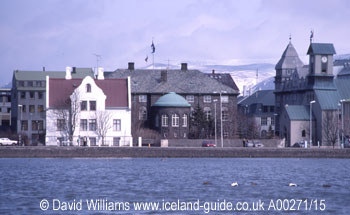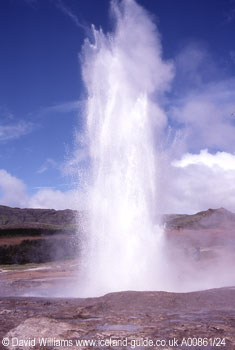 |
| These
are two of Reykjavík`s best-known buildings: on the right is
Dómkirkjan, the Lutheran cathedral and in the middle is Althingishúsið,
the Icelandic parliament building. |
|
|
| Strokkur,
Iceland`s main geyser. |
The south-west
of Iceland is the most populated part of the country and warm and damp
winds from the Atlantic Ocean help make this low-lying region the richest
agricultural area. As well as having the capital, Reykjavík, this
region has some of the country`s most popular sights: the ancient parliament
site of Thingvellir, the waterspout Geysir and the country`s best-known
volcano, Hekla.
Reykjavík, a bustling metropolis of around 100,000 people,
is the world`s most northerly capital and in contrast to the grey skies
it may get, the buildings are brightly coloured — and well-insulated!
The air is spared industrial pollution as the city`s buildings are warmed
by geothermally-heated water and in the depths of winter the warm waste
water is run through pipes under the city centre`s pavements to keep them
free of ice. Reykjavík is cosmopolitan in many ways but also very
Icelandic — where else in the world would you find lots of massive
four-wheel drive vehicles driving past an opera house? No visitor to the
capital should leave the city without trying the large outdoor swimming
pool at Laugardalur. While the energetic visitor might want to
swim a few lengths of the main pool (where the water is at 28°C),
the most remarkable attractions are the "hot pots" — small
communal tubs where the water is especially hot. Try a few of them to
find out which one suits you best — some might be as hot as 45°C!
The country`s most historic site is Thingvellir ("Plain of
All Men") where parliaments met in the open air from 930 to 1798.
It was here that Iceland declared its independence from Denmark in 1944
and celebrated the country`s eleven hundredth anniversary in 1974. This
is certainly the Icelanders` spiritual home. The setting is quite spectacular
too, as it sits in a level plain whose edges are bounded by major fissures
that are still moving slowly apart.
One of the country`s best-known attractions is the waterspout Geysir,
after which all others are named. Alas, it now lies dormant but close
to it is Strokkur, a lively geyser that shoots a column of hot
water 20m into the air every few minutes — a photographer`s dream!
Hekla lies to the east of the agricultural plain and it has threatened
the farming land ever since the first settlers arrived on the island.
In medieval times it was thought to be the entrance to Hell and the lava
bombs hurled out during eruptions were believed to be monstrous birds
or the souls of the dammed. One huge eruption in 1104 completely inundated
sixteen farms with an ash fall but in 1939 one of them, Stöng,
was excavated, and this is well worth visiting; it is surrounded by bare
ashfields, products of Hekla`s many convulsions. The volcano last erupted
in 1980 and the vapour seen rising from its summit is a reminder that
Hekla is only dormant — no-one knows when it will next erupt.
Back
to the list of articles about this country
|

